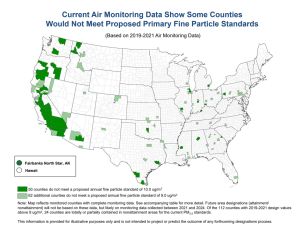 On Friday 1/6/23 a proposal was released by the Environmental Protection Agency (EPA) that could lower the maximum levels of fine particulate matter less than 2.5 microns in diameter (PM2.5) – less than the diameter of human hair – down to 9 or 10 micrograms per cubic meter of air (ug/m3) annually. A microgram is one-millionth of a gram and is the chosen unit of measure for National Ambient Air Quality Standards (NAAQS) set by the EPA. The current standard of 12 was set back in 2012 during the Obama Administration and the decade old standard was left unchanged during the Trump administration.
On Friday 1/6/23 a proposal was released by the Environmental Protection Agency (EPA) that could lower the maximum levels of fine particulate matter less than 2.5 microns in diameter (PM2.5) – less than the diameter of human hair – down to 9 or 10 micrograms per cubic meter of air (ug/m3) annually. A microgram is one-millionth of a gram and is the chosen unit of measure for National Ambient Air Quality Standards (NAAQS) set by the EPA. The current standard of 12 was set back in 2012 during the Obama Administration and the decade old standard was left unchanged during the Trump administration.
PM2.5, or soot, comes from sources including power plants, refineries, cars and trucks, and even wildfires. It is known to cause lung and heart damage and has been found to disproportionately affect low-income communities, according to the EPA. The EPA estimates that an annual PM2.5 standard of 9 ug/m3 would prevent up to 4,200 premature deaths per year and yield $43 billion in net health benefits in 2032. As such, Environmental activists are in strong support of the new proposed rule.
On the other side of the spectrum, groups representing the cement, manufacturing, oil and other industries criticized the rules for adding regulatory burdens that some facilities would not be able to comply with. EPA said the change would not force polluters to shut down, but it could be used as the basis for rule making aimed at specific sources such as diesel-fired engines and power plants.
The NAAQS must be met when a company proposes to build a new facility or modify an existing facility that triggers air dispersion modeling. Emissions are modeled using EPA approved software and those results are compared to the NAAQS. Additional controls or operating limits may be necessary to lower emissions to meet the standards. Both the annual and short-term standards must be met prior to approval being granted from regulators to proceed with construction.
While the proposed rule would strengthen the annual PM2.5 standard, depending on where the standard is actually set will depend on how impactful the economic consequences will be. For example, if the standard is set at 9 ug/m3, large areas of California would be designated as nonattainment and subject to stringent regulatory requirements that would be very restrictive to industrial project expansions and have a direct impact on jobs and economic growth of the impacted state(s). One may be surprised to see that even mostly rural western states like Idaho, Arizona, and Nevada could have areas designated as nonattainment.
Regardless of whether the standard is lowered to 8 ug/m3, 9 ug/m3 or 10 ug/m3, the greatest impact would be to California, specifically the Central Valley and southern California. However, if the EPA decided to lower the standard to 8 ug/m3, states from the Pacific North West, to the Gulf Coast, and up to New England would have nonattainment designations to deal with. According to the information found in the EPA’s Regulatory Impact Analysis for the Proposed Reconsideration of the NAAQS for PM, the following summarizes the number of counties, by alternative standard level, in each geographic area that need PM2.5 emissions reductions from the analytical baseline.
- 10/35 µg/m3– 24 counties need PM2.5 emissions reductions. This includes 4 counties in the northeast, 2 counties in the southeast, 3 counties in the west, and 15 counties in California.
- 9/35 µg/m3 — 51 counties need PM2.5 emissions reductions. This includes 14 counties in the northeast, 8 counties in the southeast, 8 counties in the west, and 21 counties in California.
- 8/35 µg/m3 — 141 counties need PM2.5 emissions reductions. This includes 57 counties in the northeast, 35 counties in the southeast, 24 counties in the west, and 25 counties in California

As with nearly every new or updated environmental regulation put forth in the last 2 decades, regardless of where the final standard lands, it is certain to be challenged in court.
The EPA will take comments during a 60-day comment period (through mid-March) and is expected to finalize the decision this summer. In accordance with the Clean Air Act, the EPA is required to review all of the NAAQS every five years. It is worth noting that the EPA left the short term 24-hour standard (35 ug/m3) unchanged.
If you have any questions about this rule or would like to discuss how it effects expansion plans at your facility please feel free to reach out to corey.gautreux@ppmco.com.

